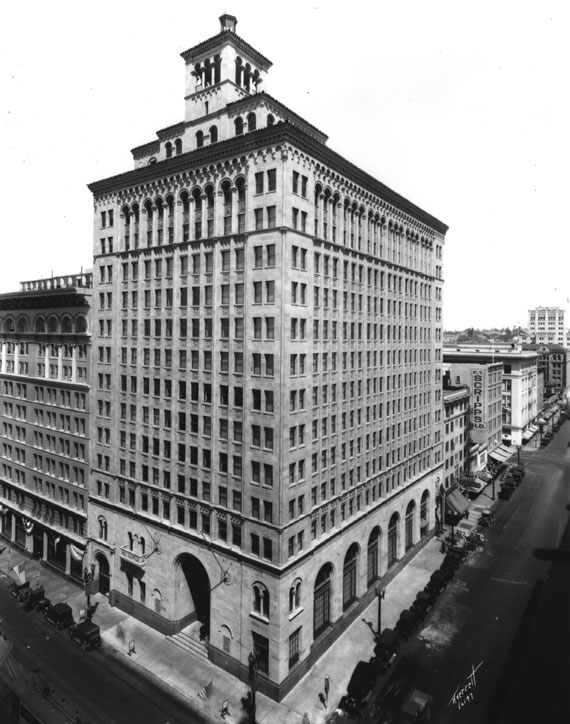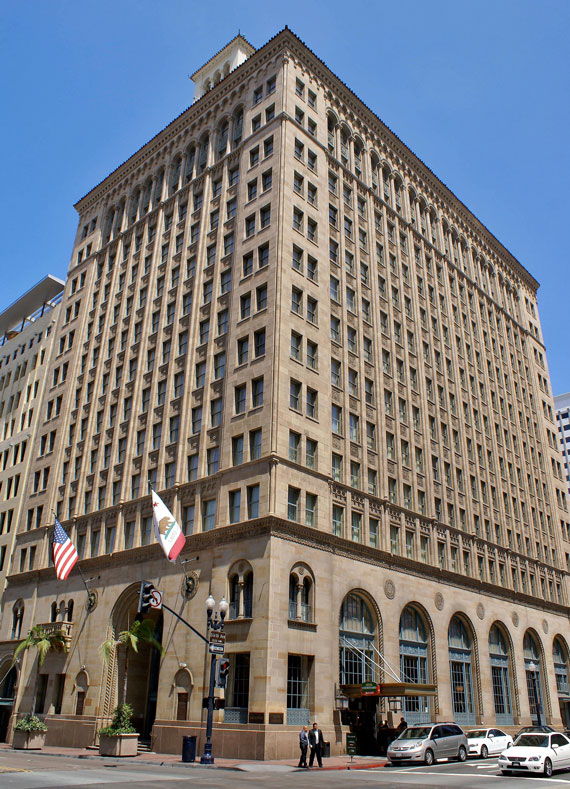|
SOHO’s 2022 Climate Change Commitment
March/April 2022
 The San Diego Trust & Savings Bank at 530 Broadway, designed by William Templeton Johnson. Photo c. 1933, courtesy National Register of Historic Places Registration Form |
 The bank closed in 1994, and in an elegant lesson in adaptive reuse, the building was reopened five years later as a Courtyard by Marriott Hotel. Photo courtesy Leonardo Worldwide |
Climate change is one of the most significant and fastest growing threats worldwide. Sea level rise and coastal flooding, drought and extreme heat, and increased frequency and intensity of severe weather events all threaten the significant built and cultural history of San Diegans and our region. As advocates for San Diego’s history, culture, and heritage, Save Our Heritage Organisation (SOHO) is committed to strengthening efforts to address climate change and support community decarbonization goals, which is why we have developed our 2022 Climate Change Commitment. Please read and share our commitment with others, and we encourage you to commit as well!
SOHO’s 2022 Climate Change Commitment
SOHO has played a leadership role in the responsible stewardship of San Diego’s historic places for over 50 years. SOHO believes that climate change is the defining issue of our time and, to combat major losses of all kinds, historic preservation must be an integral part of any effort toward environmental responsibility and sustainable development in the fight against it. Today, we stand ready in our role guiding the sustainable stewardship of our region’s future to battle against the impacts of climate change.
The greatest challenges to our historic communities, landmarks, and cultural resources are related to climate change. In the San Diego region, climate concerns are primarily sea level rise and coastal flooding, wildfires, drought and extreme heat, and increased frequency and intensity of severe weather events.
There is a direct intersection between environmental sustainability and cultural stewardship. A sense of history, place, and meaning is at risk of being lost if culture and heritage are absent from climate adaptation and mitigation. Preserving heritage sites is important to maintain traditions, historical knowledge, and community identity. Loss of cultural heritage can impede a community’s ability to recover from disasters because cultural practices and social safety nets are weakened.
Preservation has an essential role in the fight against climate change to foster sustainable stewardship, or development that is environmentally and economically lasting. Composed of embodied energy and constructed from reliable high-quality materials, historic buildings are renewable—not disposable—resources and can be adaptively reused for many purposes. The reuse of older buildings preserves not only important cultural and social associations, but saves on new materials and keeps reusable material from the landfill.
SOHO commits to the following efforts in four key areas:
Policy
- Advocate for the adoption of policies at the federal, state, and local levels that incentivize rein-vestment in existing communities, the reuse of existing buildings, and the creation of preservation guidelines that connect with climate action goals. This includes rehabilitation tax incentives, adap-tive reuse, and retaining the naturally occurring affordable housing.
- Support policy that conserves culturally significant places, incorporates climate mitigation and ad-aptation, and aims to preserve cultural heritage.
- Collaborate with planning departments, environmental groups, and others to ensure the recycling of buildings is included within broader environmental agendas.
Representation
- Help ensure all cultural heritage voices and expertise are represented in climate policy discussions.
- Work collaboratively with stakeholders to develop, implement, and enhance a climate action agen-da for cultural heritage and building arts.
- Search for agreeable solutions to preserve the past while protecting the future. This includes dis-cussing with stakeholders, how to recognize, document, and possibly partner with historic and cul-tural sites, neighborhoods, and communities as we work towards climate change, adaptation, and mitigation goals.
Preservation Solutions
- Facilitate preservation-minded solutions being included in climate discussion, such as building codes and incentives that allow flexibility and innovation to make existing buildings more energy-efficient and possible for adaptive reuse.
- Support flexible and creative climate mitigation practices, including moving buildings, deconstruction and material salvaging as a last resort. The embodied carbon of building materials is valuable to reuse when a building will be lost. Deconstruction over demolition is favorable and climate sensitive.
- Promote climate forward technologies in retrofitting historic buildings as a benefit, and not a threat, to their continual and future use including solar panels and weatherization.
Education
- Teach the benefits and refute any misconceptions about energy efficiency in older buildings, which includes how preservation is an essential tool for sustaining the environmental viability of the plan-et and quality of life for communities.
- Create messaging about the connections between climate change and heritage such as reducing car-bon emissions and mitigating climate change through building conservation, reuse, and retrofitting. Develop ambassadors to further SOHO’s climate change message.
- Seek to align the efforts of key leaders and organizations in the heritage movement and create a common platform.
- Inform the community about places where cultural heritage may be at greatest risk.
|
2025
2024
2023
2022
2021
2020
2019
2018
2017
2016
2015
|





